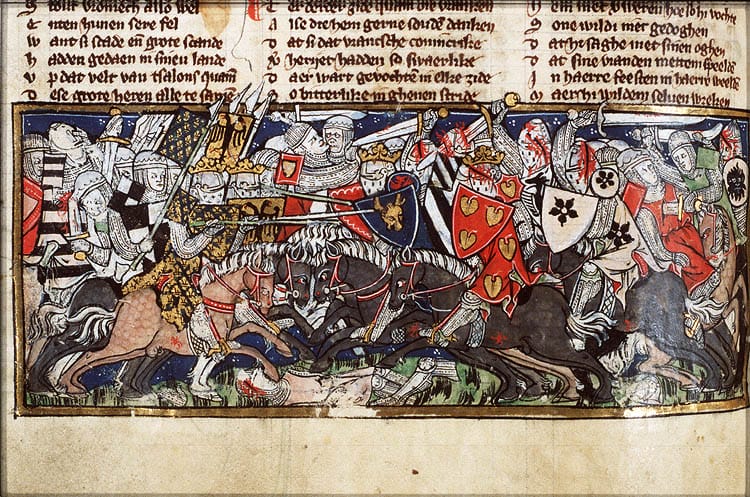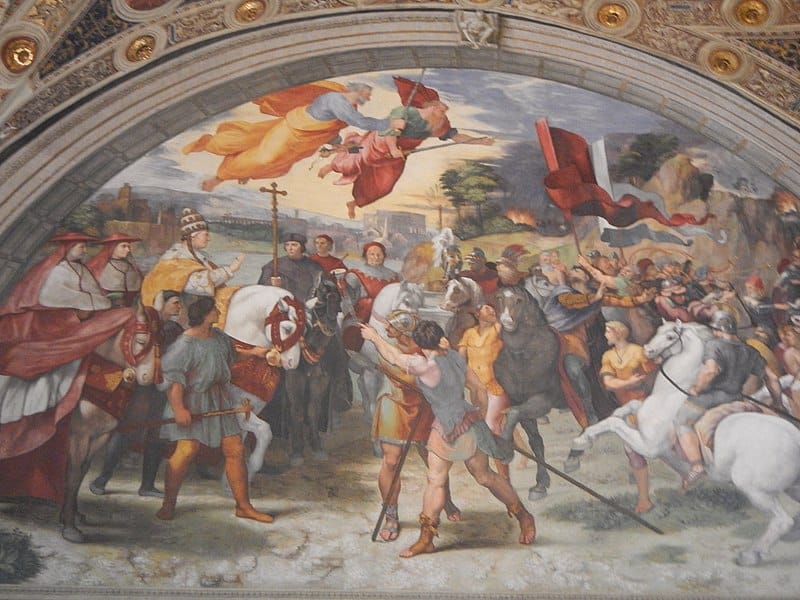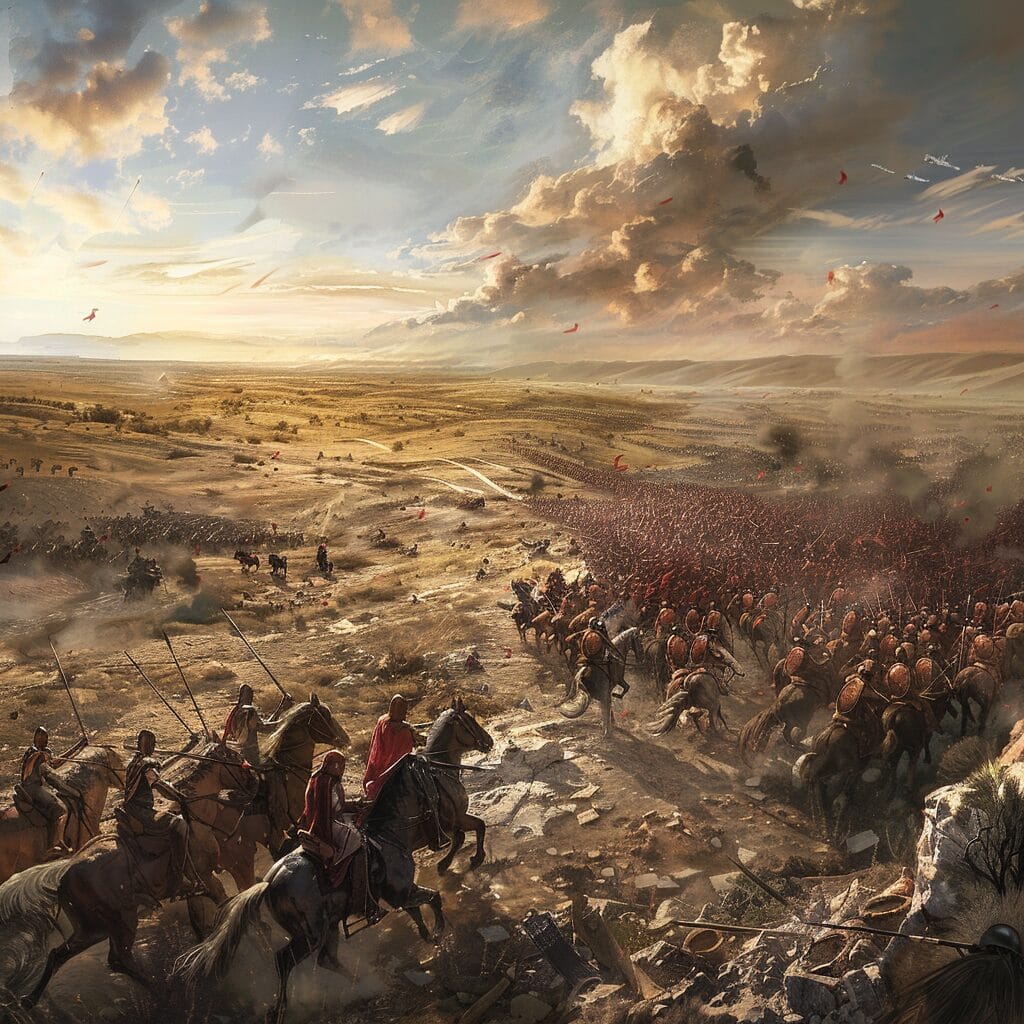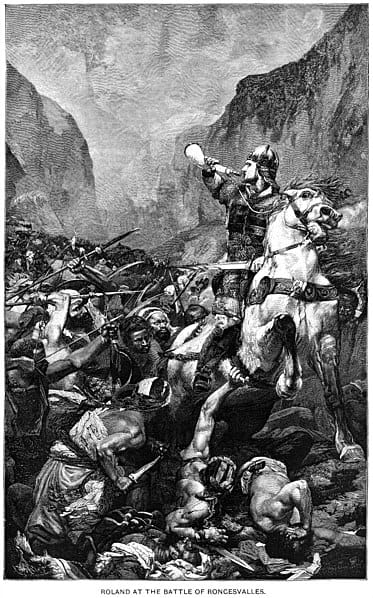The Catalaunian Plains, also known as the Battle of the Catalaunian Fields, was an extremely significant battle fought in 451 AD. The battle took place in the Catalaunian Plains, located in northeastern France, and is considered to be one of the most important battles in European history. The battle was fought between the forces of the Roman Empire and a coalition of Germanic tribes led by Attila the Hun.
The Roman Empire was facing a period of decline, and the Germanic tribes were becoming more powerful and influential. At the same time, Attila the Hun was expanding his empire and had already conquered much of Eastern Europe. The Roman Empire was facing a significant threat from Attila and his army, and they knew that they needed to defeat him to prevent further expansion.

The battle was fought between the Roman Empire, led by General Flavius Aetius, and a coalition of Germanic tribes, against Attila the Hun and another group of Germanic tribes. The battle was fierce, with both sides suffering heavy losses. However, in the end, the Roman Empire emerged victorious, and Attila was forced to retreat. The battle is considered to be one of the most significant battles in European history, as it prevented Attila from further expanding his empire and helped preserve the Roman Empire’s power for a few more years.
Key Takeaways
- The Battle of the Catalaunian Plains was fought in 451 AD in northeastern France between the Roman Empire and a coalition of Germanic tribes led by Attila the Hun.
- The battle was significant in European history as it prevented Attila from further expanding his empire and helped to preserve the Roman Empire’s power for a few more years.
- The battle was fierce, with both sides suffering heavy losses, but in the end, the Roman Empire emerged victorious.
Historical Context
In the 5th century, the Roman Empire was facing a series of invasions from various barbarian tribes. The Huns, led by their powerful leader Attila, were one of the most formidable foes of the Roman Empire. In 451 AD, the Roman General Aetius led a coalition of Roman and Germanic forces against the Huns at the Battle of the Catalaunian Plains.
The Roman Empire was struggling to maintain its power and influence in the region, and the battle was a crucial turning point in the conflict between the Romans and the Huns. The Roman victory at the Catalaunian Plains helped to halt the Hunnic advance into Western Europe and ensured the survival of the Roman Empire for another 25 years.
Hunnic Invasions and Attila
The Huns, a nomadic people from Central Asia, began their invasions of Europe in the late 4th century. Led by their charismatic leader, Attila, they quickly became a major threat to the Roman Empire. Attila was known as the “Scourge of God” and was feared throughout Europe for his military prowess and ruthless tactics.
The Battle of the Catalaunian Plains was one of the most significant battles of Attila’s career. Despite his fierce reputation, Attila was unable to defeat the Roman coalition led by Aetius. The battle marked the beginning of the end for the Huns, and Attila would die just a few years later. The Catalaunian Plains was a pivotal moment in European history. The battle helped to shape the future of the Roman Empire and marked the end of the Hunnic invasions.

Source: Emanuela Meme Giudic…, CC BY 3.0 https://creativecommons.org/licenses/by/3.0, via Wikimedia Commons
Lead-Up to the Conflict
Attila the Hun, who had recently become the sole ruler of the Hunnic Empire, had been expanding his territory and was now threatening the Roman Empire. In response, the Roman general, Flavius Aetius, assembled an army of Romans, Visigoths, Burgundians, and other allies to confront Attila. The two armies met on the Catalaunian Plains, and the battle lasted for two days. The first day was marked by heavy fighting, with neither side gaining a clear advantage.
Key Military Leaders
Both sides had experienced military leaders. Flavius Aetius, the Roman general, had previously served as a hostage in the court of Attila and had learned much about Hunnic tactics. The Visigothic king Theodoric I and the Burgundian king Gundobad also played important roles in the battle.
On the other side, Attila the Hun was a formidable military leader known for his tactical brilliance and ferocity in battle. He was assisted by his brother Bleda, who commanded a significant portion of the Hunnic forces.
Forces Involved
The exact number of troops involved in the battle is not known, but it is estimated that the Roman-led coalition had around 80,000 soldiers, while the Hunnic-led coalition had around 100,000 soldiers. The Roman-led coalition was made up of a diverse group of soldiers, including Romans, Visigoths, Burgundians, and other Germanic tribes. The Hunnic-led coalition was made up primarily of Huns but also included Alans and various Germanic tribes.
The Course of the Battle
The battle began with a series of skirmishes between the two armies. The initial engagements were fought between the Roman cavalry and the Hun cavalry, which resulted in heavy casualties on both sides.
Main Conflict
The main conflict of the battle took place when the two armies clashed in a massive infantry battle. The Roman army formed a defensive line, while the Hun army launched a series of attacks. The battle was intense, with both sides suffering heavy casualties. At one point, it appeared that the Roman army was on the verge of defeat, but they managed to hold their ground and push back the Hunarmy.
Tactical Maneuvers
Throughout the battle, both armies used a variety of tactical maneuvers to gain the upper hand. The Roman army used their cavalry to launch surprise attacks on the Hun army’s flanks, while the Hun army used their archers to rain down arrows on the Roman army. Despite the intense fighting, the battle ultimately ended in a stalemate, with both armies suffering heavy losses.
In conclusion, it was a brutal battle that lasted for several days and resulted in heavy casualties on both sides. Despite the intense fighting, the battle ultimately ended in a stalemate, with neither side emerging as the clear victor. But the Huns retreated first, so, technically the Roman army won.
Aftermath and Consequences
The Battle of Catalaunian Plains was one of the bloodiest battles in the history of Europe. The exact number of casualties is not known, but it is estimated that over 100,000 soldiers were killed in the battle. The Huns suffered heavy losses, but the Romans and their allies also suffered significant losses, with many of their soldiers killed or wounded.
The Huns were stopped from advancing further into Europe, and their power was significantly weakened. The battle also marked the end of Attila’s reign of terror, which had lasted for many years. The Romans and their allies were able to maintain their control over Europe, and they were able to prevent the Huns from invading their territories.
The Battle of Catalaunian Plains had a significant impact on the political landscape of Europe. The Romans and their allies were able to maintain their power and influence in the region, and they were able to prevent the Huns from expanding their empire. The battle marked the beginning of the end of the Roman Empire, as it was unable to maintain its power and influence in Europe for much longer. The battle also had a significant impact on the relationship between the Romans and the Germanic tribes, as they were able to work together to defeat a common enemy.

Cultural and Historical Impact
The Battle of the Catalaunian Plains, also known as the Battle of Chalons, was a significant event with deep cultural and historical impacts. This confrontation had several long-lasting effects.
Literary Accounts
It has been the subject of several literary accounts throughout history. The most famous of these is the epic poem “The Song of Roland,” which was written in the 11th century and tells the story of the Battle of Roncevaux Pass. Although the battle depicted in the poem is not the same as the Battle of Catalaunian Plains, it is believed that the two events were conflated in the minds of medieval writers.

Other literary accounts of the Battle of Catalaunian Plains include the works of the Roman historian Procopius and the Byzantine chronicler Jordanes. These accounts provide valuable information about the battle and its aftermath and have helped historians to piece together a more complete picture of the events that took place.
Legacy in Popular Culture
The Battle of Catalaunian Plains had a significant impact on popular culture, particularly in France. The battle has also been depicted in several films and television shows, including the 1964 film “The Fall of the Roman Empire” and the HBO series “Rome.” Overall, the Battle of Catalaunian Plains has had a lasting cultural and historical impact and continues to be studied and celebrated to this day.
Archaeological Discoveries
Archaeological evidence directly related to the Battle of the Catalaunian Plains has been relatively low, primarily due to the difficulties in pinpointing the exact location of the battle and the nature of archaeological investigations in such contexts. However, some discoveries and studies provide insights into this historic event and the broader context of the period.
Battlefield Excavations
Archaeological excavations around the Catalaunian Plains have revealed some information about the battle that took place there in 451 AD. The excavations have uncovered evidence of a large-scale battle, including human remains, weapons, and armor. The site has been considered the most likely location of the famous Battle of the Catalaunian Plains, fought between the Roman Empire and the Huns.
The excavations have revealed that the battle was a brutal and bloody affair, with evidence of hand-to-hand combat and significant casualties on both sides. The remains of soldiers have been found in large numbers, many of them with injuries that suggest they died in combat.
Artifacts and Relics
In addition to the human remains the excavations at the Catalaunian Plains have also uncovered a wealth of artifacts and relics from the battle. These include weapons such as swords, spears, and arrows, as well as armor and other military equipment.
One of the most significant finds at the site is a large collection of Roman coins, which were likely carried by soldiers during the battle. These coins provide valuable insight into the economy and culture of the Roman Empire at the time of the battle.
Other artifacts found at the site include pottery, jewelry, and other items that offer clues about the daily lives of the people who fought in the battle. These discoveries have helped archaeologists build a more complete picture of the events that took place at the Catalaunian Plains.
Historiographical Debates
Historiographical debates on the Battle of the Catalaunian Plains focus on several key areas, including the battle’s significance, the accuracy of historical sources, the leadership and strategies of the key figures involved, and its long-term impact.
Contemporary vs Modern Perspectives
Contemporary sources include accounts written during or shortly after the battle, such as the writings of the Roman historian Jordanes and the Byzantine historian Procopius. Modern sources, on the other hand, include accounts written centuries later, such as those by the French historian Jules Michelet and the American historian Edward Gibbon.
Some historians argue that contemporary sources are more reliable because they were written closer to the actual event and are less likely to be influenced by later biases. Others argue that modern sources provide a more subtle understanding of the battle, as they are able to draw on a wider range of sources and perspectives.
Disputed Facts
Another area of debate among historians is the interpretation of certain facts about the battle. One of the most hotly contested issues is the identity of the leaders of the opposing forces. Some historians argue that the Roman general Flavius Aetius and the Visigothic king Theodoric I led the Roman-allied forces, while others maintain that the Huns were led by Attila the Hun and the Ostrogoths were led by Theodoric the Great.
Other disputed facts include the number of troops involved in the battle, the tactics used by each side, and the overall significance of the battle in the broader context of European history.
Despite these debates, the Battle of Catalaunian Plains remains a key moment in European history, marking the end of the Hunnic threat to the Roman Empire and the beginning of a new era of political and military alliances in Europe.
People Also Ask:
The Battle of the Catalaunian Plains was one of the last major battles fought by the Roman Empire. This section aims to answer some of the most frequently asked questions about the battle.
Who were the main combatants in the Battle of the Catalaunian Plains?
The Battle of the Catalaunian Plains was fought between the Roman Empire, led by Flavius Aetius, and the Huns, led by Attila. The Roman army was composed of a coalition of various tribes, including the Visigoths, Franks, and Burgundians.
What were the reasons behind the Battle of the Catalaunian Plains?
The battle was fought in 451 AD and was a result of Attila’s invasion of Gaul. Attila had already conquered much of Eastern Europe and was now looking to expand his empire further west. The Romans, led by Flavius Aetius, saw Attila’s invasion as a threat to their own territories and decided to confront him in battle.
What was the significance of the Battle of the Catalaunian Plains in history?
It is one of the most significant battles of the late Roman Empire. It marked the end of Attila’s westward expansion and prevented him from conquering Western Europe. The battle also helped to solidify the alliance between the Roman Empire and the various tribes that had joined forces to fight the Huns.
What were the estimated casualties resulting from the Battle of the Catalaunian Plains?
The exact number of casualties resulting from the Battle of the Catalaunian Plains is unknown. However, it is believed that both sides suffered heavy losses. Some estimates suggest that as many as 300,000 soldiers may have been killed in the battle.
Which leader emerged victorious in the Battle of the Catalaunian Plains?
The Battle of the Catalaunian Plains was a brutal and bloody battle, and neither side emerged as a clear victor. However, the Roman Empire and its allies were ultimately successful in preventing Attila from conquering Western Europe.
How did the outcome of the Battle of the Catalaunian Plains influence the decline of the Roman Empire?
The Battle of the Catalaunian Plains was one of the last major battles fought by the Roman Empire. While the empire continued to decline for several more centuries, the battle marked a turning point in its history. The alliance between the various tribes that fought against the Huns helped to weaken the power of the Roman Empire and contributed to its eventual collapse.
Hello, my name is Vladimir, and I am a part of the Roman-empire writing team.
I am a historian, and history is an integral part of my life.
To be honest, while I was in school, I didn’t like history so how did I end up studying it? Well, for that, I have to thank history-based strategy PC games. Thank you so much, Europa Universalis IV, and thank you, Medieval Total War.
Since games made me fall in love with history, I completed bachelor studies at Filozofski Fakultet Niš, a part of the University of Niš. My bachelor’s thesis was about Julis Caesar. Soon, I completed my master’s studies at the same university.
For years now, I have been working as a teacher in a local elementary school, but my passion for writing isn’t fulfilled, so I decided to pursue that ambition online. There were a few gigs, but most of them were not history-related.
Then I stumbled upon roman-empire.com, and now I am a part of something bigger. No, I am not a part of the ancient Roman Empire but of a creative writing team where I have the freedom to write about whatever I want. Yes, even about Star Wars. Stay tuned for that.
Anyway, I am better at writing about Rome than writing about me. But if you would like to contact me for any reason, you can do it at [email protected]. Except for negative reviews, of course. 😀
Kind regards,
Vladimir
